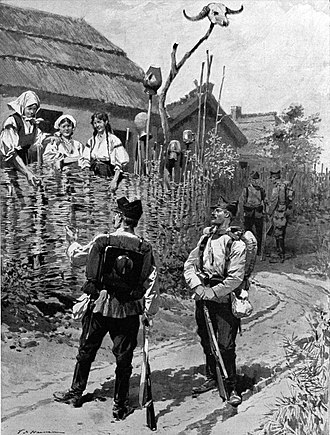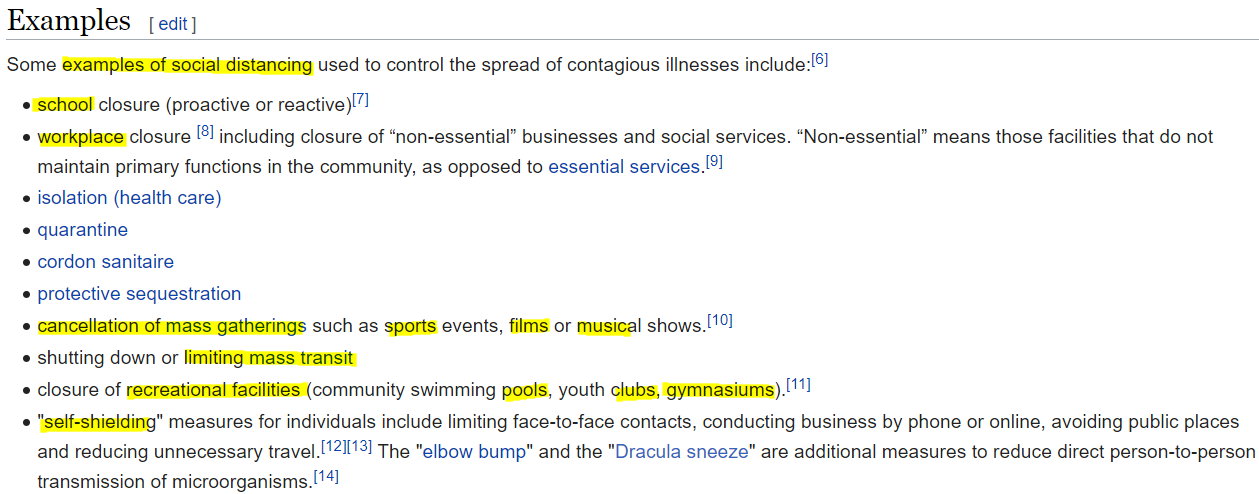'Social Distancing' - what's that?
E :
From VOX
These three public health tools could (possibly) slow the spread of the outbreak
Beyond the overarching personal message of good personal hygiene (wash your hands, don’t touch your face), there are several other broad public health strategies used to put the brakes on a viral outbreak.
Three of the most important — and sometimes confusing — ones are isolation of sick patients and tracing their contacts, quarantine, and social distancing. These phrases are often used interchangeably, but they refer to slightly different things:
- Isolation is separating those with confirmed infections from other people, so that they can get better without infecting anyone else.
- Quarantine is restricting the movement of, or isolating, people who might have been exposed to an infection but who aren’t yet sick.
- Social distancing refers to a slew of tactics meant to keep people from congregating in large crowds, to slow the spread of a virus.
All of these might be called for during an outbreak, to varying degrees of effectiveness, and result in varying degrees of hardship for individuals. Your state or local government may have the power to enforce adherence to any of these — perhaps even with law enforcement. But we shouldn’t think of these (if implemented properly) as punitive, but as a civic duty to protect the most vulnerable from Covid-19.
Here's one explanation on how to practice 'social distancing'.
The Australian Government Department of Health provides a 13 page and very complete PDF to answer this "What Is?" question.
Santa Clara County Public Health Department provides this information
which includes:
"Some examples of social distancing measures that
would be conducted during a pandemic include:
• Public and private colleges suspending classes,
going to Web-based learning and canceling
all large campus meetings and gatherings.
• Public and private libraries modifying their
operations and restricting people from gathering
by allowing people to come in only to pick up
materials that have been reserved or requested
on-line or by telephone.
• Business changing company practices, setting
up flexible shift plans, having employees
telecommute and canceling any large meetings
or conferences.
Other social distancing measures that would be used
during a pandemic include closing all public and
private K-12 schools and facilities, closing all childcare
centers, community centers, malls and theaters, as
well as suspending services at all houses of worship.
Additionally, during a pandemic all indoor and
outdoor events that attract large crowds would be
cancelled. These events include sports events,
concerts, parades and festivals. Mass transit systems
may also be temporarily closed or be used only for
essential travel."
Q: What is a cordon sanitaire?
Ans. : The term cordon sanitaire dates to 1821, when the Duke de Richelieu deployed French troops to the border between France and Spain, allegedly to prevent yellow fever from spreading into France.
Maybe other things were spreading into France as well ...
It is the restriction of movement of people into or out of a defined geographic area, such as a community, region, or country. The term originally denoted a barrier used to stop the spread of infectious diseases.
Wikipedia provides a typically informative summary of social distancing.
- ( Click image below to read more easily ) -
What about effectiveness of these measures. Do they make a difference?
- "Research indicates that measures must be applied rigorously and immediately in order to be effective.
- During the 1918 flu pandemic, authorities in the US implemented school closures, bans on public gatherings, and other social distancing interventions in Philadelphia and in St. Louis, but in Philadelphia the delay of five days in initiating these measures allowed transmission rates to double three to five times, whereas a more immediate response in St. Louis was significant in reducing transmission there.
- Bootsma and Ferguson analyzed social distancing interventions in 16 US cities during the 1918 epidemic and found that time-limited interventions reduced total mortality only moderately (perhaps 10–30%), and that the impact was often very limited because the interventions were introduced too late and lifted too early. It was observed that several cities experienced a second epidemic peak after social distancing controls were lifted, because susceptible individuals who had been protected were now exposed."
Q: Does everyone think that social distancing is a good thing in times of epidemic?
A: No. Not always.
While it may be good at an individual level, at a population level, it may have negative consequences.
"Rational individual-level preventive measures [like social distancing] can have counterintuitive consequences for the population level. Public health interventions that aim at changing individual behaviour through social distancing could have adverse consequences, for example, school closures could reduce social contacts between children in the school classes but may (partly) be replaced by social contacts outside of school. But similarly, these measures could be beneficial for the population. As our results show, it is not necessarily straightforward what effects such behaviour may have at the population level, where much may depend on the disease and population under consideration. These findings highlight the importance of understanding the properties of disease specific contact networks and modelling individual-level behavioural changes in response to an epidemic to understand infectious disease dynamics."
The above from :
"Individual preventive social distancing during an epidemic may have negative population-level outcomes" by Ka Yin Leung, Frank Ball, David Sirl and Tom Britton from Sweden and the UK
Click the link to read this very in depth and thoughtful analysis.
Inscrivez-vous au blog
Soyez prévenu par email des prochaines mises à jour
Rejoignez les 17 autres membres




